德国亥姆霍兹国家研究中心的情况介绍(2012)
- 格式:pdf
- 大小:229.11 KB
- 文档页数:12
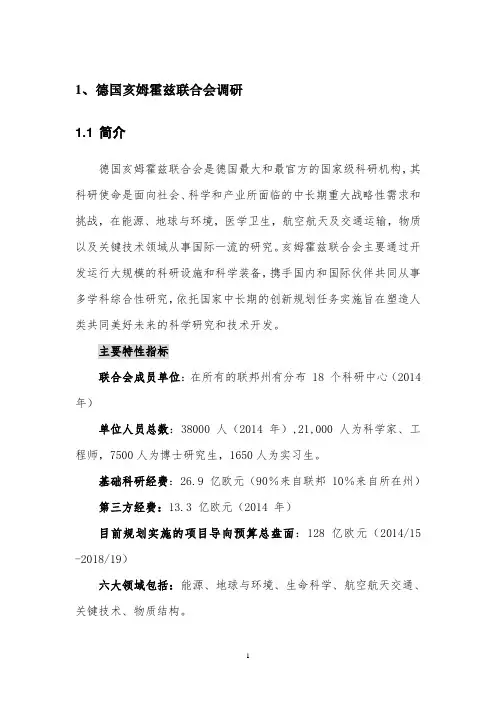
1、德国亥姆霍兹联合会调研1.1 简介德国亥姆霍兹联合会是德国最大和最官方的国家级科研机构,其科研使命是面向社会、科学和产业所面临的中长期重大战略性需求和挑战,在能源、地球与环境,医学卫生,航空航天及交通运输,物质以及关键技术领域从事国际一流的研究。
亥姆霍兹联合会主要通过开发运行大规模的科研设施和科学装备,携手国内和国际伙伴共同从事多学科综合性研究,依托国家中长期的创新规划任务实施旨在塑造人类共同美好未来的科学研究和技术开发。
主要特性指标联合会成员单位:在所有的联邦州有分布 18 个科研中心(2014 年)单位人员总数:38000 人(2014 年),21,000人为科学家、工程师,7500人为博士研究生,1650人为实习生。
基础科研经费:26.9 亿欧元(90%来自联邦 10%来自所在州)第三方经费:13.3 亿欧元(2014 年)目前规划实施的项目导向预算总盘面:128 亿欧元(2014/15 -2018/19)六大领域包括:能源、地球与环境、生命科学、航空航天交通、关键技术、物质结构。
亥姆霍兹联合会六大领域的科研工作主要解决人类社会所面临的主要挑战和重大问题,为以后和未来提出可持续的解决方案。
1.2 组织架构与法律形式亥姆霍兹联合会是一个专门注册的会员机构,目前会员包括 17 家独立法人资质的科研中心和一家非独立法人的中心。
各个会员自身享有多种不同的法律框架结构(公募基金会、注册协会,有限责任公司,国营事业单位)。
联合会自 2001 年成立之后,联合会的活动都受联合会章程的约束,所有的会员中心实施共同的科研、经费和管理架构。
联合会设置一名全职主席负责整个项目导向的经费管理转型和全机构的总体对外战略的协调。
支持联合会主席日常工作的是一位总裁、分设在柏林和波恩的两个总部以及在布鲁塞尔、北京和莫斯科三个代表处。
1.2.1组织架构联合会的核心决策群体是成员单位委员会和理事会。
其中成员单位委员会由联合会内部成员组成,理事会由外部成员组成。

德国的科研系统–德国最主要的科研机构德国高校的科学研究所德国马克斯.普朗克学会(MPG,简称马普学会)亥姆霍兹联合会(HGF)弗劳恩霍夫应用研究促进协会(FhG)莱布尼茨科学联合会(WGL)各联邦州的科研院所德国的公共科学资助德国科学基金会(DFG)德意志学术交流中心(DAAD)德国洪堡基金会(AvH)德国民众奖学金基金会国家科学管理机构德国联邦教育与研究部(BMBF)德国联邦环境部(BMU)德国联邦经济与技术部(BMWi)德国科学联席会(GWK)民间科学研究德国企业界的研究与投资德国联邦工业合作研究会(AiF)"Ottovon Guericke" 民间科学基金会德国科学赞助者联合会大众汽车基金会罗伯特· 博世基金会蒂森科学基金会克虏伯基金会德国的科学院欧洲科研资助机构欧盟委员会欧洲研究理事会(ERC)欧洲科学基金会(ESF德国最主要的科研机构德国共有700多家公共财政支持的科研机构,按照所属关系主要分为以下几类:德国高校的科学研究所从数量上来说,从事科研工作最多的机构是分布在德国各联邦州的高等院校(见地图http://www.bmbf.de/de/6574.php)。
德国总共有282所高校,其中103所大学和176所理工高校。
德国科学基金会(DFG)资助名单显示,德国的40所大学在科研方面较为突出。
威廉·冯·洪堡提出的“教研合一”的理念缔结了德国高校科学人才培养和科研工作相符合的传统。
高校科研的重点在于基础研究,与此同时也在相应的学科领域进行应用研究。
因此而言,德国高校的科研领域几乎是包罗万象的。
德国高校的科研经费主要由政府财政拨款,同时也接受私人基金会的资助或者接受委托研究。
2005年德国高校用于研发经费共计92.2亿欧元,其中36.6亿欧元是第三方经费(出自:德国联邦统计局主页http://www.destatis.de)。
(第三方经费是指科研资助经费中除了主管部委拨付给科研机构的基本预算经费外,来自私人企业或公共科研资助机构(比如德国科学基金会)的经费)。
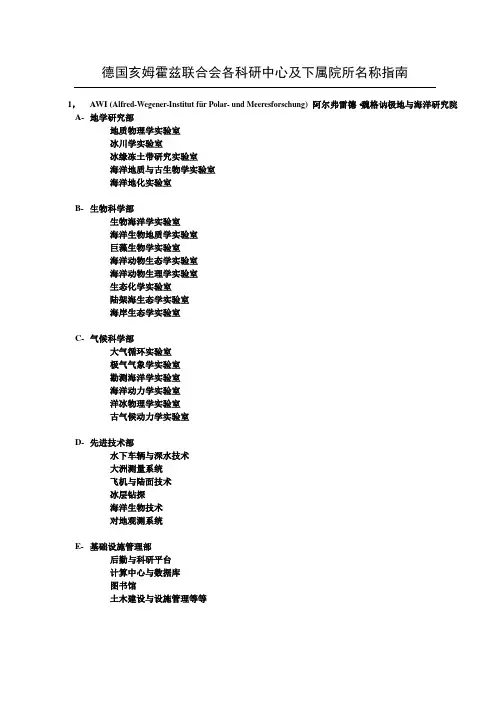
德国亥姆霍兹联合会各科研中心及下属院所名称指南1,AWI (Alfred-Wegener-Institut für Polar- und Meeresforschung) 阿尔弗雷德·魏格讷极地与海洋研究院A-地学研究部地质物理学实验室冰川学实验室冰缘冻土带研究实验室海洋地质与古生物学实验室海洋地化实验室B-生物科学部生物海洋学实验室海洋生物地质学实验室巨藻生物学实验室海洋动物生态学实验室海洋动物生理学实验室生态化学实验室陆架海生态学实验室海岸生态学实验室C-气候科学部大气循环实验室极气气象学实验室勘测海洋学实验室海洋动力学实验室洋冰物理学实验室古气候动力学实验室D-先进技术部水下车辆与深水技术大洲测量系统飞机与陆面技术冰层钻探海洋生物技术对地观测系统E-基础设施管理部后勤与科研平台计算中心与数据库图书馆土木建设与设施管理等等2,DESY (Deutsches Elektronen-Synchrotron DESY)德国电子同步辐射装置加速器部光子学研究部高能粒子物理学部3,DKFZ( Deutsches Krebsforschungszentrum) 德国癌症研究中心细胞生物学与肿瘤生物学结构与功能基因组学致癌风险因素及预防肿瘤免疫学成像与肿瘤放谢学感染与癌症肿瘤治疗的对接应用4,DLR (Deutsches Zentrum für Luft- und Raumfahrt) 德国航空航天中心德国遥感数据中心DFD飞行推进研究所空港事务与航空交通研究所航空动力与湍流技术研究所气动弹力研究所推进技术研究所建筑事务与构造研究所概念车研究所纤维轻结构与自适应研究所飞行制导研究所飞行系统技术研究所高频技术与雷达系统研究所通讯与导航研究所航空与航天医学研究所空间材料物理学研究所遥感技术研究所大气物理学研究所行星研究所太空飞行推进技术研发!究所太空飞行系统研究所机器人与机电一体化研究所技术物理所技术热动所燃烧技术研究所交通技术研究所交通系统研究所材料研究所空间飞行推进与航天员训练所模拟与软件技术所5,FZJ (Forschungszentrum Jülich)于利希研究中心高级模拟研究院(IAS - Institute for Advanced Simulation)于利希超级计算中心材料的量子理论软物质与生物物理理论结构成形理论生物技术研究院(Institut für Biotechnologie - IBT)生物技术一所物质转换调节与代谢工程实验室微生物生理学实验室氨基酸与细胞壁实验室细菌的蛋白质分泌实验室调节开关与合成生物学实验室生物技术二所技术生物触酶实验室发酵技术实验室生物纳米系统研究院(Institut für Bio- und Nanosysteme)IBN-1所:半导体薄膜与设备IBN-2所:生物电子学IBN-3所:界面与表面IBN-4所:生物膜层IBN-工艺技术部IBN-技术与设施管理部化学与地质环境动态研究院(Institut für Chemie und Dynamik der Geosphäre) ICG-1 平流层研究所ICG-2 对流层研究所ICG-3 植物圈研究所ICG-4 农艺圈研究所能源研究所(Institut für Energieforschung)IEF-1所:材料合成与生产工艺IEF-2所:材料结构与性能IEF-3所:燃料电池IEF-4所:等离子体物理IEF-5所:光电所IEF-6所:安全研究与反应堆技术IEF-STE:系统研究与工艺研发IEF-PBZ:燃料电池项目总协调IEF-KFS:核聚变项目总协调固体研究院(Institut für Festkörperforschung)IFF-1所:材料的量子理论IFF-2所:软材料与生物物理理论IFF-3所:结构形成理论IFF-4所:散射方法IFF-5所:中子散射IFF-6所:电子态材料IFF-7所:软物质IFF-8所:微结构研究IFF-9所:电子特征研究IFF-TA部:技术及管理设施6,FZK (Forschungszentrum Karlsruhe)卡尔斯鲁厄研究中心7,GSI (Helmholtzzentrum für Schwerionenforschung)亥姆霍兹重离子研究中心8,GKSS (GKSS Forschungszentrum Geesthacht ) GKSS吉斯塔赫研究中心9,HZB (Helmholtz-Zentrum Berlin für Materialien und Energie亥姆霍兹柏林材料与能源中心10,HZI (Helmholtz-Zentrum für Infektionsforschung)亥姆霍兹感染中心11,HZGU (Helmholtz Zentrum München - Deutsches Forschungszentrum für Gesundheit und Umwelt) 亥姆霍兹慕尼黑中心-德国健康与环境中心12,HZU (Helmholtz-Zentrum für Umweltforschung - UFZ)亥姆霍兹环境研究中心UFZ13,GFZ (Helmholtz-Zentrum Potsdam Deutsches GeoForschungsZentrum) 亥姆霍兹波兹坦中心-德国地学研究中心14,MDC (Max-Delbrück-Centrum für Molekulare Medizin Berlin-Buch)马克斯德尔布吕克分子医学中心15,IPP (Max-Planck-Institut für Plasmaphysik)马克斯普朗克等离子物理研究院。
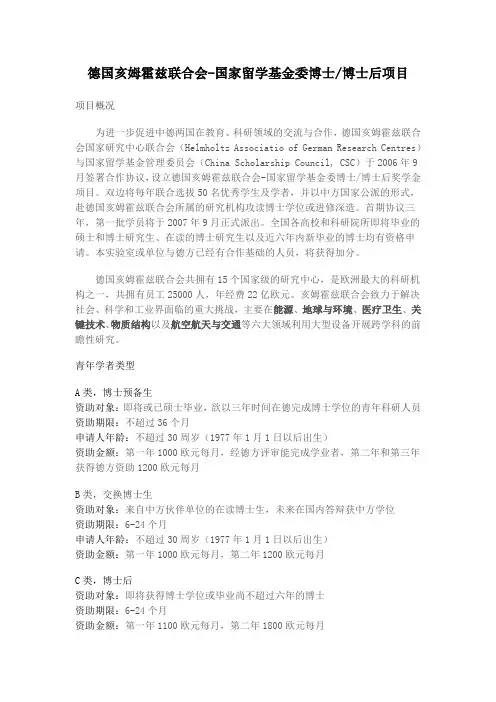
德国亥姆霍兹联合会-国家留学基金委博士/博士后项目项目概况为进一步促进中德两国在教育、科研领域的交流与合作,德国亥姆霍兹联合会国家研究中心联合会(Helmholtz Associatio of German Research Centres)与国家留学基金管理委员会(China Scholarship Council, CSC)于2006年9月签署合作协议,设立德国亥姆霍兹联合会-国家留学基金委博士/博士后奖学金项目。
双边将每年联合选拔50名优秀学生及学者,并以中方国家公派的形式,赴德国亥姆霍兹联合会所属的研究机构攻读博士学位或进修深造。
首期协议三年,第一批学员将于2007年9月正式派出。
全国各高校和科研院所即将毕业的硕士和博士研究生、在读的博士研究生以及近六年内新毕业的博士均有资格申请。
本实验室或单位与德方已经有合作基础的人员,将获得加分。
德国亥姆霍兹联合会共拥有15个国家级的研究中心,是欧洲最大的科研机构之一,共拥有员工25000人,年经费22亿欧元。
亥姆霍兹联合会致力于解决社会、科学和工业界面临的重大挑战,主要在能源、地球与环境、医疗卫生、关键技术、物质结构以及航空航天与交通等六大领域利用大型设备开展跨学科的前瞻性研究。
青年学者类型A类,博士预备生资助对象:即将或已硕士毕业,欲以三年时间在德完成博士学位的青年科研人员资助期限:不超过36个月申请人年龄:不超过30周岁(1977年1月1日以后出生)资助金额:第一年1000欧元每月,经德方评审能完成学业者,第二年和第三年获得德方资助1200欧元每月B类,交换博士生资助对象:来自中方伙伴单位的在读博士生,未来在国内答辩获中方学位资助期限:6-24个月申请人年龄:不超过30周岁(1977年1月1日以后出生)资助金额:第一年1000欧元每月,第二年1200欧元每月C类,博士后资助对象:即将获得博士学位或毕业尚不超过六年的博士资助期限:6-24个月资助金额:第一年1100欧元每月,第二年1800欧元每月申请程序:因是联合奖学金项目,申请程序分为两步,分别是国外部分与国内部分。
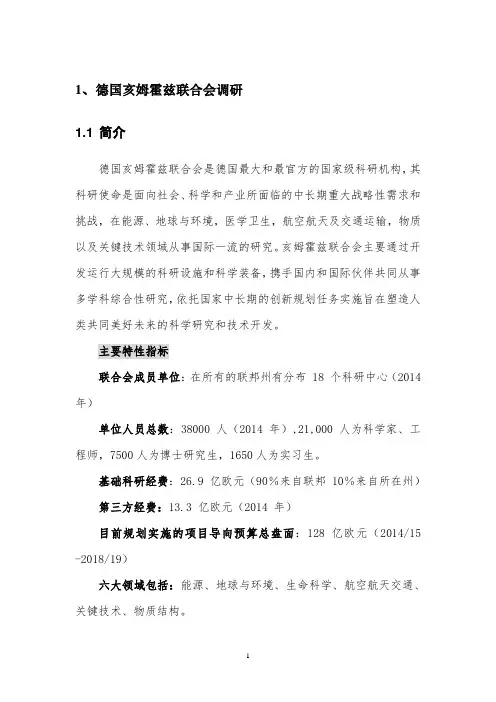
1、德国亥姆霍兹联合会调研1.1 简介德国亥姆霍兹联合会是德国最大和最官方的国家级科研机构,其科研使命是面向社会、科学和产业所面临的中长期重大战略性需求和挑战,在能源、地球与环境,医学卫生,航空航天及交通运输,物质以及关键技术领域从事国际一流的研究。
亥姆霍兹联合会主要通过开发运行大规模的科研设施和科学装备,携手国内和国际伙伴共同从事多学科综合性研究,依托国家中长期的创新规划任务实施旨在塑造人类共同美好未来的科学研究和技术开发。
主要特性指标联合会成员单位:在所有的联邦州有分布 18 个科研中心(2014 年)单位人员总数:38000 人(2014 年),21,000人为科学家、工程师,7500人为博士研究生,1650人为实习生。
基础科研经费:26.9 亿欧元(90%来自联邦 10%来自所在州)第三方经费:13.3 亿欧元(2014 年)目前规划实施的项目导向预算总盘面:128 亿欧元(2014/15 -2018/19)六大领域包括:能源、地球与环境、生命科学、航空航天交通、关键技术、物质结构。
亥姆霍兹联合会六大领域的科研工作主要解决人类社会所面临的主要挑战和重大问题,为以后和未来提出可持续的解决方案。
1.2 组织架构与法律形式亥姆霍兹联合会是一个专门注册的会员机构,目前会员包括 17 家独立法人资质的科研中心和一家非独立法人的中心。
各个会员自身享有多种不同的法律框架结构(公募基金会、注册协会,有限责任公司,国营事业单位)。
联合会自 2001 年成立之后,联合会的活动都受联合会章程的约束,所有的会员中心实施共同的科研、经费和管理架构。
联合会设置一名全职主席负责整个项目导向的经费管理转型和全机构的总体对外战略的协调。
支持联合会主席日常工作的是一位总裁、分设在柏林和波恩的两个总部以及在布鲁塞尔、北京和莫斯科三个代表处。
1.2.1组织架构联合会的核心决策群体是成员单位委员会和理事会。
其中成员单位委员会由联合会内部成员组成,理事会由外部成员组成。
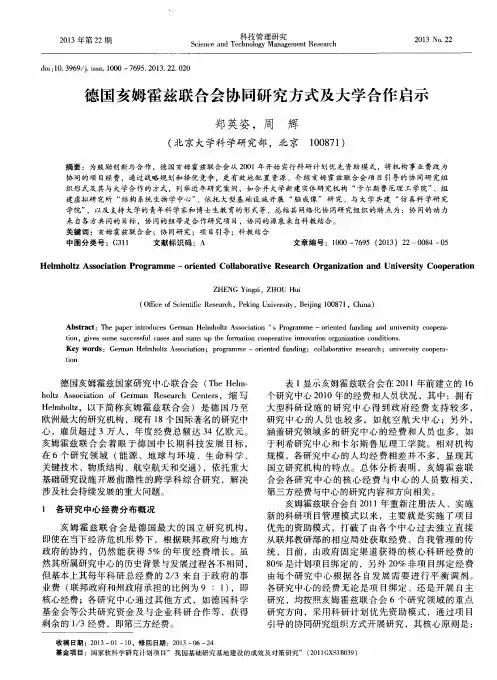
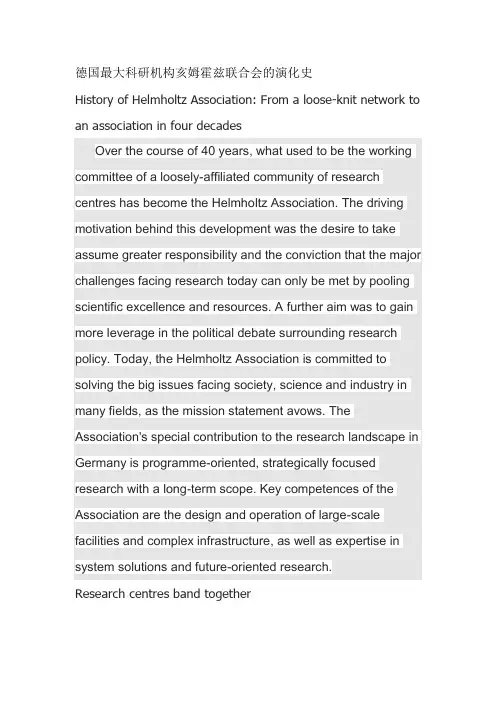
德国最大科研机构亥姆霍兹联合会的演化史History of Helmholtz Association: From a loose-knit network to an association in four decadesOver the course of 40 years, what used to be the working committee of a loosely-affiliated community of research centres has become the Helmholtz Association. The driving motivation behind this development was the desire to take assume greater responsibility and the conviction that the major challenges facing research today can only be met by pooling scientific excellence and resources. A further aim was to gain more leverage in the political debate surrounding research policy. Today, the Helmholtz Association is committed to solving the big issues facing society, science and industry in many fields, as the mission statement avows. The Association's special contribution to the research landscape in Germany is programme-oriented, strategically focused research with a long-term scope. Key competences of the Association are the design and operation of large-scale facilities and complex infrastructure, as well as expertise in system solutions and future-oriented research.Research centres band togetherIn order to accomplish the first great task - developing safe and powerful nuclear reactors - representatives from the Karlsruhe and Jülich research centres, which were still in the process of being established, met in 1958 with the former Society for Nuclear Energy Management in Shipbuilding and Shipping Navigation (known today as Helmholtz-Zentrum Geesthacht Centre for Materials and Coastal Research) and the nuclear research institutes of a number of universities to form the "Working committee for administrative and operational affairs in German reactor control stations". The former Hahn Meitner Institute for Nuclear Research in Berlin joined the committee in the following year, 1959.Initially the committee focused on the exchange of experiences related to operational and safety issues, but soon the focus was expanded to include topics that still concern the large research centres today.. These involve questions of strategic orientation, training, remuneration and patent management, which are all of great importance for the advancement of excellent research and its practical and commercial application. It is for this reason that research centres involved in other scientific fields, but dedicated to solving similar problems joined the Association in the 1960s.These were the Deutsches Elektronen Synchroton (DESY), the Radiation Research Society (now the Helmholtz Zentrum München - German Research Center for Environmental Health), the Max Planck Institute of Plasma Physics, the German Test and Research Institute for Aviation and Space Flight (now the German Aerospace Center), the former Society for Mathematics and Data Processing (part of the Fraunhofer Institute today) and the Society for Heavy Ion Research (GSI).The articles of association and a new structure legitimised this grouping together of research associations, with the aim of avoiding bureaucratic micromanagement andover-interference in research. Today, the government's role in formulating research policy guidelines and the Association's mission to address the big issues facing, science and industry are more clearly defined.The Association's relationship to the German government is definedAt the beginning of 1970, representatives of the research centres formed the Arbeitsgemeinschaft derGroßforschungseinrichtungen" (syndicate of large-scale research institutes), or AGF, and formulated the guidelines that would govern their relationship to the government. Working ina spirit of partnership, the AGF aimed to define the basic tasks the Association would concern itself with; implementing the guidelines would be the responsibility of the individual research centres.The German Cancer Research Centre joined the AGF in 1975, followed a year later by the German Research Centre for Biotechnology (GBF ), now renamed the Helmholtz Centre for Infection Research). In 1983, the Alfred Wegener Institute for Polar and Marine Research became a member. The Association saw further growth as a result of German reunification, when research centres in the new federal states - including the GFZ Geosciences Research Centre in Potsdam, the Max Delbrück Center for Molecular Medicine and the former Leipzig-Halle Centre for Environmental Research (known today as the Helmholtz Centre for Environmental Research, or UFZ) - were admitted as members.Strength and excellence through integration and initiative In 1995, the AGF became the Helmholtz Association of German Research Centres. The research institutes came one step closer to achieving their aim of freedom to govern their own affairs. Since then, a senior council has provided recommendations on major issues relating to content andstructure, such as the practice of appointing professors jointly with universities, principles of the appraisal procedure and research priorities.2001 was a significant milestone in the restructuring of the Association. The loose affiliation was transformed into a registered association with legally independent member centres. The core of the reform with regard to content was the introduction of the programme-oriented advancement of funding, which involved a switch from centre-oriented financing, in which each centre administered its own budget, to superordinate financing at the level of the Association. A total of 30 cross-centre research programmes have been drafted, which are evaluated in detail by internationally-renowned experts with regard to their strategic relevance and scientific excellence. The Helmholtz Association is the only research organisation in recent years to have initiated comparable reforms that have resulted in the reorientation of research efforts towards strategic goals.The reform also gave the Association a full-time president. With the Initiative and Networking Fund, he has an effective tool at his disposal for setting strategic priorities, as well as for promoting scientific excellence and advancing research in keyfields with the required critical mass. The strategically-oriented Initiative and Networking Fund has established an incentive scheme that promotes scientific competition. Along with other funding schemes, it also supports the goals of the Helmholtz Association within the scope of the Pact for Research and Innovation. In concentrating on excellence, new forms of cooperation and networking, promoting the young scientific community and the development of new approaches to further innovation, the Association contribute to economic growth and prosperity in our society.Following the amendment of the articles of association at the end of 2006, each of the Association's different fields of research is represented by a vice president in the newly established executive committee; in addition, there are two vice presidents with administrative duties.The reforms in recent years set the course for the Helmholtz Association to become one of the most important and highly-regarded scientific organisations in Germany today.The Helmholtz-Zentrum Berlin für Materialien und Energie was created on 1 January 2009 when the formerHahn-Meitner-Institut Berlin (HMI) merged with another Berlininstitute, the Elektronenspeicherring-Gesellschaft für Synchrotronstrahlung (BESSY).The newly founded German Center for Neurodegenerative Diseases (DZNE) has been a member of the Helmholtz Association since 30 April 2009. The 16th Research Centre to join, the DZNE is unique in two ways. Firstly, it is not limited to a single location; instead it is made up of a strong interdisciplinary network consisting of the core facility in Bonn and (currently) six outstanding partner locations inRostock/Greifswald, Magdeburg, Göttingen, Witten-Herdecke, Tübingen and Munich. Secondly, unlike other European research institutes in the field, the DZNE does not focus on basic research alone, but also translates research findings into practice. On 1 January 2011 the Forschungszentrum Dresden-Rossendorf (FZD) became the 17th member of the Association, under the new name Helmholtz-Zentrum Dresden Rossendorf (HZDR). A year later on 1 January 2012 the former Leibniz Institute of Marine Sciences (IFM-GEOMAR) converted into GEOMAR | Helmholtz Centre for Ocean Research Kiel due to the transition of the institute into the Helmholtz Association.。
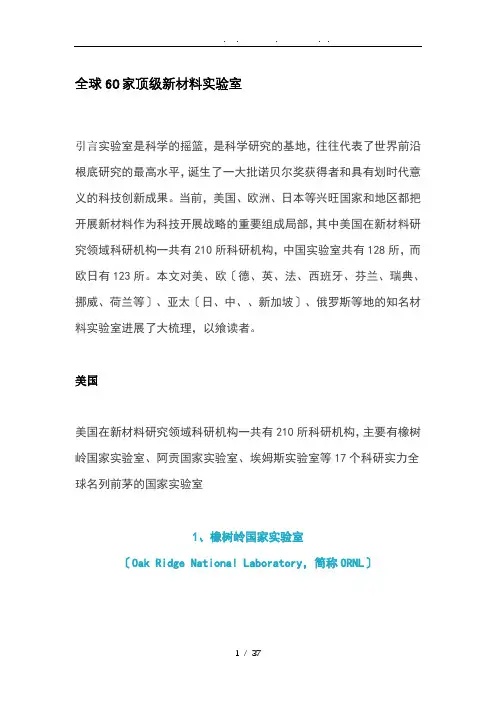
全球60家顶级新材料实验室引言实验室是科学的摇篮,是科学研究的基地,往往代表了世界前沿根底研究的最高水平,诞生了一大批诺贝尔奖获得者和具有划时代意义的科技创新成果。
当前,美国、欧洲、日本等兴旺国家和地区都把开展新材料作为科技开展战略的重要组成局部,其中美国在新材料研究领域科研机构一共有210所科研机构,中国实验室共有128所,而欧日有123所。
本文对美、欧〔德、英、法、西班牙、芬兰、瑞典、挪威、荷兰等〕、亚太〔日、中、、新加坡〕、俄罗斯等地的知名材料实验室进展了大梳理,以飨读者。
美国美国在新材料研究领域科研机构一共有210所科研机构,主要有橡树岭国家实验室、阿贡国家实验室、埃姆斯实验室等17个科研实力全球名列前茅的国家实验室1、橡树岭国家实验室〔Oak Ridge National Laboratory,简称ORNL〕据理财周报材料科学实验室数据说明,橡树岭国家实验室的科研触角主要伸向纳米与生物材料、无机非金属材料以与新型金属材料三大类别。
橡树岭国家实验室(简称ORNL)是美国能源部所属最大的科学和能源研究实验室。
ORNL主要从事6个方面的研究,包括中子科学、能源、高性能计算、复杂生物系统、先进材料和国家安全。
2、阿贡国家实验室〔ArgonneNational Laboratory,简称ANL〕在美国,阿贡国家实验室和橡树岭国家实验室同属于美国国家能源部,和橡树岭的地位不分伯仲。
阿贡国家实验室是美国最老和最大的科学与工程研究实验室之一。
3、美国航空航天局〔NASA〕位于特拉华州的NASA主要涉足新型金属材料以与高性能复合材料。
今年9月,NASA选择了来自美国5个州的六家公司参与政府-行业合作,以推进复合材料的研究和认证,该项目是NASA航空研究任务理事会的集成系统研究计划的一局部。
4、布鲁克海文国家实验室〔BrookhavenNational Laboratory,简称BNL〕隶属美国能源部,由石溪大学和BATTELLE成立的公司布鲁克海文科学学会负责管理。
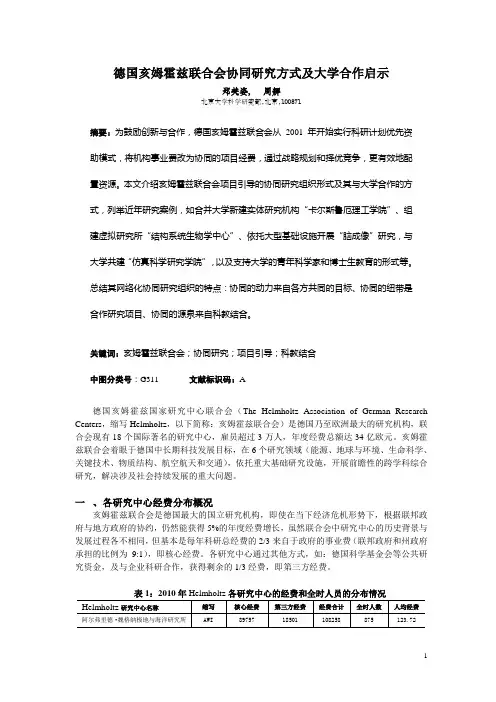
德国亥姆霍兹联合会协同研究方式及大学合作启示郑英姿, 周辉北京大学科学研究部,北京,100871摘要:为鼓励创新与合作,德国亥姆霍兹联合会从2001年开始实行科研计划优先资助模式,将机构事业费改为协同的项目经费,通过战略规划和择优竞争,更有效地配置资源。
本文介绍亥姆霍兹联合会项目引导的协同研究组织形式及其与大学合作的方式,列举近年研究案例,如合并大学新建实体研究机构“卡尔斯鲁厄理工学院”、组建虚拟研究所“结构系统生物学中心”、依托大型基础设施开展“脑成像”研究,与大学共建“仿真科学研究学院”,以及支持大学的青年科学家和博士生教育的形式等。
总结其网络化协同研究组织的特点:协同的动力来自各方共同的目标、协同的纽带是合作研究项目、协同的源泉来自科教结合。
关键词:亥姆霍兹联合会;协同研究;项目引导;科教结合中图分类号:G311文献标识码:A德国亥姆霍兹国家研究中心联合会(The Helmholtz Association of German Research Centers,缩写Helmholtz,以下简称:亥姆霍兹联合会)是德国乃至欧洲最大的研究机构,联合会现有18个国际著名的研究中心,雇员超过3万人,年度经费总额达34亿欧元。
亥姆霍兹联合会着眼于德国中长期科技发展目标,在6个研究领域(能源、地球与环境、生命科学、关键技术、物质结构、航空航天和交通),依托重大基础研究设施,开展前瞻性的跨学科综合研究,解决涉及社会持续发展的重大问题。
一、各研究中心经费分布概况亥姆霍兹联合会是德国最大的国立研究机构,即使在当下经济危机形势下,根据联邦政府与地方政府的协约,仍然能获得5%的年度经费增长,虽然联合会中研究中心的历史背景与发展过程各不相同,但基本是每年科研总经费的2/3来自于政府的事业费(联邦政府和州政府承担的比例为9:1),即核心经费。
各研究中心通过其他方式,如:德国科学基金会等公共研究资金,及与企业科研合作,获得剩余的1/3经费,即第三方经费。

德国研究所
德国研究所是德国科研领域最重要的机构之一。
德国一直以来注重科学和技术的发展,多年来在科学研究领域取得了许多重要的成果。
德国研究所作为国家级的科研机构,起着重要的指导和支持作用。
德国研究所的数目很多,涵盖了各个领域的科学研究,如自然科学、生物医药、工程技术、社会科学等。
这些研究所分布在德国各个州和城市,包括柏林、慕尼黑、科隆等。
这些研究所在德国的科学研究发展中起着重要的推动作用。
德国研究所采用分散的管理结构,每个研究所都有自己的研究方向和研究项目。
研究所的研究人员通常由一些杰出的科学家组成,他们在自己的领域内具有丰富的经验和专业知识。
研究人员通常会进行各种实验和研究,以探索和解决当前领域的科学难题。
德国研究所的研究成果对于国家的科学和技术发展起到了重要的推动作用。
这些研究成果不仅应用于实际生产和技术领域,还对学术研究和教育起到了重要的影响。
德国研究所还与国内外其他科研机构进行广泛的合作,开展科研项目和交流活动,促进了科学研究的国际合作与学术交流。
德国研究所也为年轻科学家提供了重要的培养和发展平台。
研究所通常拥有丰富的资源和设施,提供良好的科研环境和实验条件,以培养和支持年轻科学家的发展。
研究所还会举办各种科学研讨会和学术活动,为年轻科学家提供展示和交流的机会。
总而言之,德国研究所是德国科研领域最重要的机构之一。
它们在各个领域的科学研究中发挥着重要的作用,推动着科学和技术的发展。
德国研究所为年轻科学家提供了培养和发展的平台,促进了科学研究的国际合作和学术交流。

德国亥姆霍兹国家研究中心联合会德国亥姆霍兹国家研究中心联合会,原名"大科学中心联合会",是德国最大的科研实体,同时也是全欧洲最大的两家科研机构之一(另一家是法国国家科学研究中心,但是法国这家机构还含有很多社会科学方面的成份,另外许多研究力量依托于高校)。
亥姆霍兹联合会于2002年开始启动项目优先的经费体制及项目管理体制的全面改革,整合了联合会内部的人力及设备资源,并依据项目的本身对国家发展、对科技创新、对社会、经济的重要性的贡献,本着节省经费,加大产出的要求,加强了在科研领域、科研方向以及科研课题之间的横向竞争。
同时,也因此大大提高了与德国其他科研机构和高校、以及国外相应科研机构之间开展实质性合作的需求。
着眼于中国巨大的人才资源及丰富的自然资源,着眼于中国经济的持续快速发展,亥姆霍兹国家研究中心联合会把发展对中国的战略合作伙伴关系视作一个工作重点,并因此而在内部改革告一段落之后,于今年7月26日正式在北京设立了代表处,旨在全面推动和促进中德科技合作。
中国人大常委会副委员长、中国科学院院长路甬祥、中国科技部副部长刘燕华、国家基金委主任陈宜瑜、国家工程院副院长、中国医学科学院院长刘德培等中方领导共同出席了代表处成立的隆重仪式。
亥姆霍兹联合会下属15个国际著名的研究中心,共250个各有物色的研究所,员工总数超过24,000名,联合会每年的科研经费总额超过21亿欧元。
亥姆霍兹联合会在国际上代表着德国的国家科技研究形象,主要特征是围绕大型科研设备展开国际一流的大科学研究,在德国境内以及国际科技界拥有很多协作伙伴,充分体现着科技进步、创新应用相结合并进而直接影响社会发展远景的鲜明特色。
亥姆霍兹联合会主要着眼于德国国家的中长期科技任务,通过前瞻性的科学研究,从政治上、科技上研究解决人类社会的可持续发展难题,同时为继续保障德国经济的具有强大竞争力提供技术支持。
联合会实行科学家团体的自我管理,充分依赖各研究中心杰出的科学家、高效运转的科研设施以及现代化的科研管理保障以上重大目标的实现。
德国最大的科研团体-亥姆霍兹联合会,规模和影响力超过马普所亥姆霍兹联合会 (Helmholtz Association of German Research Centres,www.helmholtz.de)是德国最大的科研团体。
联合会每年获得的科研经费总额超过34亿欧元,其中来自政府渠道的经费相当于德国另外三大科研团体:马克斯.普朗克学会、莱布尼兹联合会及弗劳恩霍夫协会三家的总和。
联合会在国际学术界代表着德国的国家科技研究形象,联合会希望能够对人类现在与未来所面临的具有决定意义的问题给出答案:安全可靠的能源供应、资源的可持续利用、未来社会的正常运转或以前无法治愈疾病的治疗。
亥姆霍兹联合会将其科研活动集中在六个主要研究领域:能源、地球与环境、生命科学、关键技术、物质结构和交通与航天,科研活动为人类社会未来的可持续发展提供了可靠的保证。
亥姆霍兹联合会共包括19个国家级的研究中心(注意,我们熟知的卡尔斯鲁厄理工学院,居然是亥姆霍兹联合会19个国家级中心之一),有31,745多名科技人员利用最现代化的科学设备,特别是大型仪器和装置,从事从天体物理学(Astrophysics)、生物学(Biology)到细胞学(Cell Research)各方面的研究。
这些研究设施同时也向全世界的学者开放。
作为代表国家的科研人员,亥姆霍兹的科学家们非常明确自身的使命:为解决社会发展所面临的重大问题贡献自己的一份微薄之力。
•阿尔弗里德·瓦格纳极地与海洋研究所(AWI)阿尔弗里德·韦格纳研究所的研究人员主要从事极地、海洋与气候方面的研究。
他们希望揭示由于自然原因和人类活动所引起的地球环境系统的变化。
•亥姆霍兹信息安全中心 (CISPA)亥姆霍兹信息安全中心(CISPA)是隶属于亥姆霍兹协会的德国国家大科学机构,是德国最大的致力于信息安全研究的科学组织,并计划建成为全球最大的信息技术安全研究中心。
它的研究内容包括信息安全的所有方面,尤其是安全和隐私的前沿话题。
(1965年) 德国亥姆霍兹传染研究中心2020-10-22(正文字数:5312)上图:Covid-19冠状病毒颗粒的3D显示全世界都在密切关注新冠肺炎疫情,未来疫情会怎样?坚守严谨的德国科研机构--德国亥姆霍兹传染研究中心更加谨慎。
2020.2.12该中心流行病学项目负责人热拉尔·克劳泽说:“我们对此还不清楚。
”这个回答好像答非所问,但有3种可能的发展趋势。
1、发生全球大流行如果目前不是最糟糕的情况,那么可以想象的最糟糕情况是什么样子?新冠病毒可能在未来几个月内传播到世界各地。
1957年就发生超过100万人死于新的H2N2流感病毒。
如果新冠病毒传播到没有能力检测出感染者且遏制措施不能有效发挥作用的国家,那么现在可能也会发生这种情况。
那样的话,这些地方可能会暴发新疫情。
注解:H2N2流感病毒,1957年2月最初发生在贵州省南部,当时仅北京市就有总人口数40-50%的人患上感冒,是我国建国以来出现的最严重的流感疫情。
3月~4月传播到香港,随后急剧扩散亚洲的所有国家,接着又在澳洲、美洲和欧洲登陆,历遍了几十个国家。
在8个月的流行期内,“亚洲大流感”造成了最少100万人死亡。
2、在某个时候消失专家们一直在努力控制疫情。
该国仍然希望通过严格的隔离规定来实现这一目标,例如对一些人实行严格的旅行限制和出门限制。
3、表现如普通流感引克劳泽的话说,如果未能把新冠病毒疫情阻挡在单一地区,“这可能是最现实的情形”。
被感染的人可能会在不知道自己携带病毒的情况下离开,然后又感染其他人。
那不一定意味着一场灾难。
这种病原体可能会长期在人群中传播。
世界范围内约有1/5的死亡可归因于传染病,而与消减有关的各种问题现在比以往任何时候都大。
对于这些疾病中的许多,既没有手术保护性疫苗也没有有效的治疗方法。
地处德国布伦瑞克(Braunschweig)的亥姆霍兹感染研究中心(HZI)把应对这项医学挑战作为自己当仁不让的使命。
为了长期应对传染病,迫切需要新的活性成分和预防药物。
德国的科研系统–德国最主要的科研机构德国高校的科学研究所德国马克斯.普朗克学会(MPG,简称马普学会)亥姆霍兹联合会(HGF)弗劳恩霍夫应用研究促进协会(FhG)莱布尼茨科学联合会(WGL)各联邦州的科研院所德国的公共科学资助德国科学基金会(DFG)德意志学术交流中心(DAAD)德国洪堡基金会(AvH)德国民众奖学金基金会国家科学管理机构德国联邦教育与研究部(BMBF)德国联邦环境部(BMU)德国联邦经济与技术部(BMWi)德国科学联席会(GWK)民间科学研究德国企业界的研究与投资德国联邦工业合作研究会(AiF)"Ottovon Guericke" 民间科学基金会德国科学赞助者联合会大众汽车基金会罗伯特· 博世基金会蒂森科学基金会克虏伯基金会德国的科学院欧洲科研资助机构欧盟委员会欧洲研究理事会(ERC)欧洲科学基金会(ESF德国最主要的科研机构德国共有700多家公共财政支持的科研机构,按照所属关系主要分为以下几类:德国高校的科学研究所从数量上来说,从事科研工作最多的机构是分布在德国各联邦州的高等院校(见地图http://www.bmbf.de/de/6574.php)。
德国总共有282所高校,其中103所大学和176所理工高校。
德国科学基金会(DFG)资助名单显示,德国的40所大学在科研方面较为突出。
威廉·冯·洪堡提出的“教研合一”的理念缔结了德国高校科学人才培养和科研工作相符合的传统。
高校科研的重点在于基础研究,与此同时也在相应的学科领域进行应用研究。
因此而言,德国高校的科研领域几乎是包罗万象的。
德国高校的科研经费主要由政府财政拨款,同时也接受私人基金会的资助或者接受委托研究。
2005年德国高校用于研发经费共计92.2亿欧元,其中36.6亿欧元是第三方经费(出自:德国联邦统计局主页http://www.destatis.de)。
(第三方经费是指科研资助经费中除了主管部委拨付给科研机构的基本预算经费外,来自私人企业或公共科研资助机构(比如德国科学基金会)的经费)。